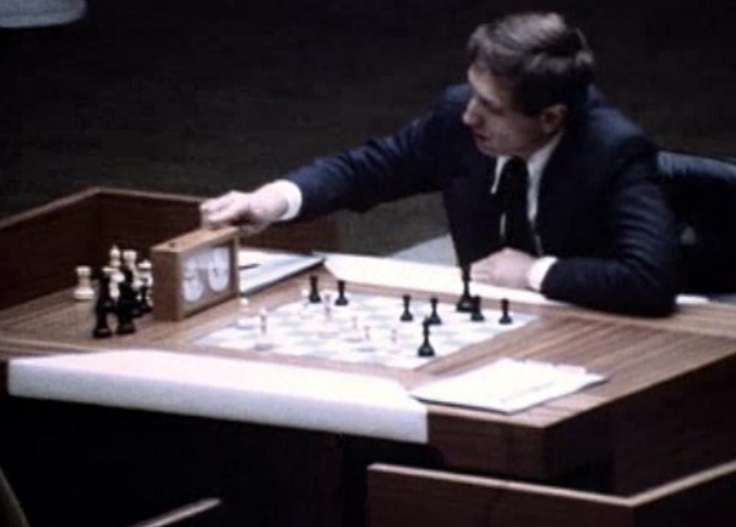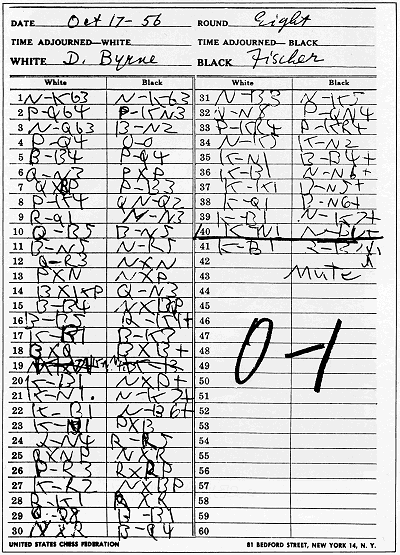The Times in Chess
Aspects of chess are often packaged into insights to apply in other areas. But you don't need chess to tell you to think before you act. And think a lot of moves ahead is neither particularly useful nor true (strong players aren’t strong because they see dozens of moves ahead).
There might be deeper insights, though. Have you noticed how there are various kinds of time in a chess game?

(Fischer toying with all sorts of time, Reykjavik, 1972)
Clock time vs Game time1
Clock time is the duration measured by the clocks. It's what is most visible to the casual observer. One doesn’t even need to look at the board to note its passage, just glances at the clock. Or more indirectly at the scoresheet which too is recording time in its own way.
White-black. Tick-tock.

(Scoresheet of Byrne vs Fischer, 1956 dubbed ‘The Game of the Century’)
Game time is more interesting. Chess commentary and game annotations are always hinting at the existence of this sort of time. A king being described as too slow because it cannot reach a pawn in time to stop it from queening, a side being lauded for its fast development, and so on.
Game time is what you really talk about when you talk about chess. Clock time is a practical constraint so tournaments can be planned, and is almost completely forgotten once the game is over. A game that took one hour to play out and one that took four hours is analyzed similarly.
Chess formalizes game time with the concepts of tempo and initiative. When a player has the initiative it is her ideas that are being responded to, and the opponent is relegated to responding until he generates what is termed as counterplay.
One rough, non-exhaustive way to spot changes in tempo might be to look for moves suffixed by symbols (!, !!, ?, ??, ?!, +) in the annotations. These would be the moves that would be mentioned when the story of the game is told.
Grandmaster Larry Evans considers four elements of chess: pawn structure, force (material), space (controlling the center and piece mobility), and time. Time is measured in tempos. Having a time advantage is having the initiative (Evans 1958:123). The initiative should be kept as long as possible and only given up for another advantage (Capablanca & de Firmian 2006:65–66).
Humans had already figured out these ideas, but an AI development from 2017 raised their importance even more.
AlphaZero
DeepMind released AlphaZero (AZ) which beat strong engines like Stockfish. Humans have been pairing with computers to improve at chess for some time now, but AZ is special. It offered us fresh insights into chess due to the way it was trained.
AZ learned just by playing against itself. Unlike other engines which are seeded with human heuristics, AZ was only given the rules of the game. This means that it was unbiased by human ideas of how a game should be played. It had to discover its own ideas. It didn’t play like engines play. It didn’t play like humans play. It has been called “alien chess” and “chess from another dimension”.
When its games with Stockfish were analyzed, among the themes that stood out were how it masterfully maximizes the activity of its pieces and keeps the initiative while denying it to the opponent. It doesn’t care about material evaluations in the way usual engines do, and it sacrifices for long-term gains.
The book Game Changer goes into more details about what we can learn from AZ’s games.
When AZ, which searches just 80k positions/second beats Stockfish which does 70 million/second, we know that it isn’t winning by brute force, and I can’t help but think of instances of small, flexible forces beating large, inflexible: startups vs big business, guerillas vs armies, David vs Goliath.
Can this be applied to other areas?
Here are three references from the military that seem to parallel the lesson about initiative from above.
Sun Tzu said "Speed is the essence of war. Take the unexpected route, attack him unaware."
Jocko Willink likes saying default aggressive. This phrasing seems to favor unthinking brashness but if you listen to the explanations it is more in line with the next reference.
John Boyd said that time is the most effective weapon. This results in the advice to control the tempo2 of an engagement. To get inside the enemy’s OODA loop.
Military lessons from chess, although natural, might seem limiting, but keep in mind that lessons from military have a long history of being adapted to business. Business strategy is downstream of military strategy. Notice how central measures of time (cycle time, takt time, lead time) are to lean thinking and its siblings. “ Sketch first, color later” increases tempo by delivering small work packets at a faster rhythm.
Some of these connections are not obvious. The discussion on chess and its stripped down version of tempo doesn’t directly lead to them. We will get to more general versions of tempo later. Chess just served to introduce the notion of various types of time co-existing around us.
We saw how there is a different time within the constructed reality of chess. Might this be true of other games? References to life as a game or a series of games are common in books (e.g. Finite and Infinite Games, Games Indians Play) and conversations. Maybe there are game times of the fractal games of life that we should be noticing more.
Time is fascinating. I expect to return to it many, uh, times.
PS: If you know about Samay Raina’s chess videos you might think that a reference to them was staring me right in the face considering that Samay means time and Raina refers to a particular window of time. Well, it was. Staring, and ordering me to work it in elegantly. But since I couldn’t, here’s me doing it inelegantly.
Another classification could be: clock, game, moves, psychological. Here we are ignoring the latter two. Move time is tightly bound to clock time, and psychological time is being ignored, as it is being considered as tightly bound to game time, which is to say that the players are playing the board and not the opponent. ↩︎
Here tempo is being used differently from how it was defined in chess. The idea is similar but a generic definition of tempo will serve us better. We will get to it later. ↩︎